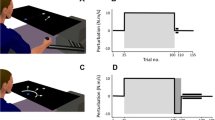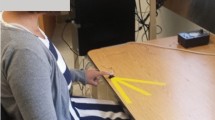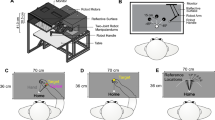Abstract
Proprioceptive information arises from a variety of channels, including muscle, tendon, and skin afferents. It tells us where our static limbs are in space and how they are moving. It remains unclear however, how these proprioceptive modes contribute to motor learning. Here, we studied a subject (IW) who has lost large myelinated fibres below the neck and found that he was strongly impaired in sensing the static position of his upper limbs, when passively moved to an unseen location. When making reaching movements however, his ability to discriminate in which direction the trajectory had been diverted was unimpaired. This dissociation allowed us to test the involvement of static and dynamic proprioception in motor learning. We found that IW showed a preserved ability to adapt to force fields when visual feedback was present. He was even sensitive to the exact form of the force perturbation, responding appropriately to a velocity- or position-dependent force after a single perturbation. The ability to adapt to force fields was also preserved when visual feedback about the lateral perturbation of the hand was withdrawn. In this experiment, however, he did not exhibit a form of use-dependent learning, which was evident in the control participants as a drift of the intended direction of the reaching movement in the perturbed direction. This suggests that this form of learning may depend on static position sense at the end of the movement. Our results indicate that dynamic and static proprioception play dissociable roles in motor learning.






Similar content being viewed by others
References
Adamovich SV, Berkinblit MB, Fookson O, Poizner H (1998) Pointing in 3D space to remembered targets. I. Kinesthetic versus visual target presentation. J Neurophysiol 79:2833–2846
Aimonetti JM, Hospod V, Roll JP, Ribot-Ciscar E (2007) Cutaneous afferents provide a neuronal population vector that encodes the orientation of human ankle movements. J Physiol 580:649–658
Bernier PM, Chua R, Bard C, Franks IM (2006) Updating of an internal model without proprioception: a deafferentation study. NeuroReport 17:1421–1425
Bhanpuri NH, Okamura AM, Bastian AJ (2013) Predictive modeling by the cerebellum improves proprioception. J Neurosci 33:14301–14306
Capaday C, Darling WG, Stanek K, Van Vreeswijk C (2013) Pointing to oneself: active versus passive proprioception revisited and implications for internal models of motor system function. Exp Brain Res 229:171–180
Cole JD, Katifi HA (1991) Evoked potentials in a man with a complete large myelinated fibre sensory neuropathy below the neck. Electroencephalogr Clin Neurophysiol 80:103–107
Cole JD, Sedgwick EM (1992) The perceptions of force and of movement in a man without large myelinated sensory afferents below the neck. J Physiol 449:503–515
Cole JD, Merton WL, Barrett G, Katifi HA, Treede RD (1995) Evoked potentials in a subject with a large-fibre sensory neuropathy below the neck. Can J Physiol Pharmacol 73:234–245
Cole J, Bushnell MC, McGlone F, Elam M, Lamarre Y, Vallbo A, Olausson H (2006) Unmyelinated tactile afferents underpin detection of low-force monofilaments. Muscle Nerve 34:105–107
Diedrichsen J, White O, Newman D, Lally N (2010) Use-dependent and error-based learning of motor behaviors. J Neurosci 30:5159–5166
Edin BB, Vallbo AB (1990) Dynamic response of human muscle spindle afferents to stretch. J Neurophysiol 63:1297–1306
Forget R, Lamarre Y (1987) Rapid elbow flexion in the absence of proprioceptive and cutaneous feedback. Hum Neurobiol 6:27–37
Fuentes CT, Bastian AJ (2010) Where is your arm? Variations in proprioception across space and tasks. J Neurophysiol 103:164–171
Gandevia SC, McCloskey DI, Burke D (1992) Kinaesthetic signals and muscle contraction. Trends Neurosci 15:62–65
Gilman S (2002) Joint position sense and vibration sense: anatomical organisation and assessment. J Neurol Neurosurg Psychiatry 73:473–477
Gritsenko V, Krouchev NI, Kalaska JF (2007) Afferent input, efference copy, signal noise, and biases in perception of joint angle during active versus passive elbow movements. J Neurophysiol 98:1140–1154
Hammerbeck U, Yousif N, Greenwood R, Rothwell JC, Diedrichsen J (2014) Movement speed is biased by prior experience. J Neurophysiol 111:128–134
Houk J, Henneman E (1967) Responses of Golgi tendon organs to active contractions of the soleus muscle of the cat. J Neurophysiol 30:466–481
Jones SA, Cressman EK, Henriques DY (2010) Proprioceptive localization of the left and right hands. Exp Brain Res 204:373–383
Laufer Y, Hocherman S, Dickstein R (2001) Accuracy of reproducing hand position when using active compared with passive movement. Physiother Res Int 6:65–75
Matthews BH (1933) Nerve endings in mammalian muscle. J Physiol 78:1–53
Melendez-Calderon A, Masia L, Gassert R, Sandini G, Burdet E (2011) Force field adaptation can be learned using vision in the absence of proprioceptive error. IEEE Trans Neural Syst Rehabil Eng 19:298–306
Ostry DJ, Darainy M, Mattar AA, Wong J, Gribble PL (2010) Somatosensory plasticity and motor learning. J Neurosci 30:5384–5393
Paillard JB, Brouchon M (1968) Active and passive movements in the calibration of position sense. In: Freeman SJ (ed) The neuropsychology of spatially oriented behaviour. Dorsey Press, Homewood, IL, pp 37–55
Polit A, Bizzi E (1978) Processes controlling arm movements in monkeys. Science 201:1235–1237
Prochazka A, Wand P (1980) Tendon organ discharge during voluntary movements in cats. J Physiol 303:385–390
Rothwell JC, Traub MM, Day BL, Obeso JA, Thomas PK, Marsden CD (1982) Manual motor performance in a deafferented man. Brain 105(Pt 3):515–542
Sainburg RL, Ghilardi MF, Poizner H, Ghez C (1995) Control of limb dynamics in normal subjects and patients without proprioception. J Neurophysiol 73:820–835
Sanes JN, Mauritz KH, Dalakas MC, Evarts EV (1985) Motor control in humans with large-fiber sensory neuropathy. Hum Neurobiol 4:101–114
Sarlegna FR, Malfait N, Bringoux L, Bourdin C, Vercher JL (2010) Force-field adaptation without proprioception: can vision be used to model limb dynamics? Neuropsychologia 48:60–67
Sing GC, Joiner WM, Nanayakkara T, Brayanov JB, Smith MA (2009) Primitives for motor adaptation reflect correlated neural tuning to position and velocity. Neuron 64:575–589
Stevens SS (1957) On the psychophysical law. Psychol Rev 64:153–181
van Beers RJ, Sittig AC, Denier van der Gon JJ (1998) The precision of proprioceptive position sense. Exp Brain Res 122:367–377
Verstynen T, Sabes PN (2011) How each movement changes the next: an experimental and theoretical study of fast adaptive priors in reaching. J Neurosci 31:10050–10059
Wong JD, Kistemaker DA, Chin A, Gribble PL (2012) Can proprioceptive training improve motor learning? J Neurophysiol 108:3313–3321
Acknowledgments
NY is funded by a medical research grant from the Bupa Foundation.
Conflict of interest
The authors report no conflict of interest.
Author information
Authors and Affiliations
Corresponding author
Rights and permissions
About this article
Cite this article
Yousif, N., Cole, J., Rothwell, J. et al. Proprioception in motor learning: lessons from a deafferented subject. Exp Brain Res 233, 2449–2459 (2015). https://doi.org/10.1007/s00221-015-4315-8
Received:
Accepted:
Published:
Issue Date:
DOI: https://doi.org/10.1007/s00221-015-4315-8




